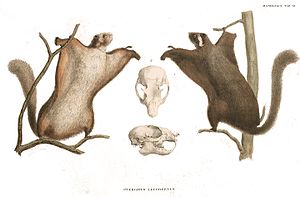Japanese giant sliding squirrel
| Japanese giant sliding squirrel | ||||||||||||
|---|---|---|---|---|---|---|---|---|---|---|---|---|

Japanese giant flying squirrel |
||||||||||||
| Systematics | ||||||||||||
|
||||||||||||
| Scientific name | ||||||||||||
| Petaurista leucogenys | ||||||||||||
| ( Temminck , 1827) |
The Japanese giant flying squirrel ( Petaurista leucogenys ) is a flying squirrel from the genus of the giant flying squirrel ( Petaurista ). It is common in parts of Japan and South Korea .
features
The Japanese giant gliding squirrel reaches a head-torso length of 36 to 46 centimeters and a tail length of 36 to 46.5 centimeters. The weight is around 1.2 kilograms. The back color is variable and can range from red-brown to almost black and gray-yellowish, the ventral side is yellowish-brown to white.
Like all giant flying squirrels, it has a large and hairy flight membrane that connects the wrists and ankles and is enlarged by a fold of skin between the hind legs and the base of the tail. The flight membrane is muscular and reinforced at the edge, it can be tensed and relaxed accordingly in order to control the direction of gliding.
The Japanese flying squirrel ( Pteromys momonga ), which occurs in the same area of distribution, is significantly smaller and only reaches about 15% of the body size of the Japanese giant flying squirrel .
distribution

The Japanese giant sliding squirrel occurs in Japan on the islands of Honshū , Kyushu and Shikoku . In addition, one of the four subspecies can be found outside of Japan in the area of the city of Seoul in South Korea .
Way of life
The Japanese giant sliding squirrel occurs in the primary and secondary forests of its range. The animals are nocturnal and the activity time usually begins around 30 minutes after sunset. Compared to smaller squirrels, the Japanese giant sliding squirrel spends a lot of time foraging for food and reaches the leaves and other plant materials by sitting with its hind legs on smaller branches and reaching for the leaves with its arms. Like other species, it is strictly arboreal and feeds on leaves and other parts of plants vegetarian, whereby there is a seasonal change between a diet largely oriented towards leaves and flowers ( folivory ) in winter as well as spring and early summer (while the females are pregnant) to a large extent nutrition ( granivory ) determined by seeds in late summer (during the suckling phase), autumn and early winter. The animals use around 45 plant species for food, on average the average share of leaves is 26 to 40%, that of seeds 34% and that of the cones of various conifers around 12%, plus pine needles and other plant parts in small quantities . Parts of the collected food are hoarded in food stores.
Like all flying squirrels, this species is also able to glide over long distances by jumping off a tree. It reaches horizontal distances of around 10 to 100 meters, on average 17 to 33 meters. The ratio between the horizontal distance and the height overcome is 1.87 to 3.5; this means a height distance of 1.7 meters to 3.3 meters with a gliding flight of ten meters in length. The speed during gliding was measured at 3.3 to 7.0 m / s and 4.4 to 9.5 m / s, respectively. The action spaces of several animals partially overlap strongly and the main activity takes place in heterogeneous secondary forests, in which the food supply is greatest. They build nests in tree hollows or in the branches of taller trees in older forests.
Two reproduction periods have been documented for the Japanese giant flying squirrel. One phase extends from mid-May to mid-June and another from mid-November to January. The average gestation period is 74 days, followed by about 91 days of lactation. From about the 80th day after birth, the young animals begin to feed themselves.
Systematics
The Japanese giant sliding squirrel is classified as an independent species within the genus of the giant sliding squirrel ( Petaurista ), which contains a total of eight to nine species. The first scientific description comes from Coenraad-Jacob Temminck from 1827 using individuals from the island of Kyushu.
Four subspecies are distinguished within the species (descriptions according to):
- Petaurista leucogenys leucogenys ( nominate form ), is known from Shikoku and southern Kyushu
- Petaurista leucogenys hintoni , lives in the Seoul area , South Korea
- Petaurista leucogenys nikkonis , lives in the region around Nikkō, centrally on the island of Honshū
- Petaurista leucogenys oreas , lives in the region around Wakayama in the south of Honshū
Existence, endangerment and protection
The Japanese giant sliding squirrel is classified as not endangered (least concern) by the International Union for Conservation of Nature and Natural Resources (IUCN) due to its comparatively large distribution area and its supposedly large populations as well as its good adaptability to changed ecosystems.
supporting documents
- ↑ a b c d e f g h i j Richard W. Thorington Jr., John L. Koprowski, Michael A. Steele: Squirrels of the World. Johns Hopkins University Press, Baltimore MD 2012; Pp. 113-115. ISBN 978-1-4214-0469-1
- ^ Richard W. Thorington Jr., John L. Koprowski, Michael A. Steele: Squirrels of the World. Johns Hopkins University Press, Baltimore MD 2012; Pp. 128-129. ISBN 978-1-4214-0469-1
- ↑ a b c Petaurista leucogenys in the IUCN Red List of Threatened Species 2010.4. Posted by: N. Ishii, Y. Kaneko, 2008. Retrieved June 22, 2014.
- ^ A b Don E. Wilson & DeeAnn M. Reeder (eds.): Petaurista leucogenys in Mammal Species of the World. A Taxonomic and Geographic Reference (3rd ed).
literature
- Richard W. Thorington Jr., John L. Koprowski, Michael A. Steele: Squirrels of the World. Johns Hopkins University Press, Baltimore MD 2012; Pp. 113-115. ISBN 978-1-4214-0469-1 .
Web links
- Petaurista leucogenys inthe IUCN Red List of Threatened Species 2010.4. Posted by: N. Ishii, Y. Kaneko, 2008. Retrieved June 22, 2014.